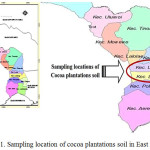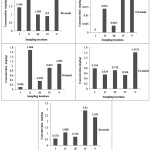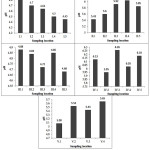Heavy Metal Content of Cocoa Plantation Soil in East Kolaka, Indonesia.
Zul Arham1, La Ode Asmin1, Rosmini1 and Muhammad Nurdin2
1Department of Mathematics and Natural Sciences, Faculty of Tarbiyah, Institut Agama Islam Negeri (IAIN) Kendari 93117 – Souteast Sulawesi, Indonesia.
2Department of Chemistry, Faculty of Mathematics and Natural Sciences, Universitas Halu Oleo, Kendari 93232 – Southeast Sulawesi, Indonesia.
Corresponding Author E-mail: arhamzul88@yahoo.com
DOI : http://dx.doi.org/10.13005/ojc/330314
Investigations of pH and heavy metals contents of Pb, Cd, Ni, Cu, and Zn in cocoa plantations soil of East Kolaka has been conducted by using pH starter Ohaus 3000 and Atomic Absorption Spectroscopy (AAS) Shimadzu AA6300. Based on the investigation, it is known that acidic soil plantation with pH ranges between 4.45 to 6.26, and also contains Pb, Cd, Ni, Cu, and Zn with an average concentration (mg/kg) are 1.45, 0.02, 0.85, 0.77, and 1.49, respectively. The existence of Pb and Cd in plantation soil have been exceeded the WHO permissible, whereas Ni, Cu, and Zn is still within the permissible limits. Acidic soil plantation will give opportunity metal ions such as Pb2+, Cd2+, Ni2+, Cu2+, Zn2+, and Al3+ absorbed by plants. Thus causing the accumulation in plant tissues and make the cocoa plants stress of heavy metals.
KEYWORDS:East Kolaka; cocoa plantation soil; heavy metals; pH; cocoa plant (Theobroma cacao L.).
Download this article as:| Copy the following to cite this article: Arham Z, Asmin L. O, Rosmini, Nurdin M. Heavy Metal Content of Cocoa Plantation Soil in East Kolaka, Indonesia.. Orient J Chem 2017;33(3). |
| Copy the following to cite this URL: Arham Z, Asmin L. O, Rosmini, Nurdin M. Heavy Metal Content of Cocoa Plantation Soil in East Kolaka, Indonesia.. Orient J Chem 2017;33(3). Available from: http://www.orientjchem.org/?p=33540 |
Introduction
The use of phosphate fertilizers and pesticides in an effort to increase crop production has been reported as a concern all over the world, both governments and environmental agencies1,2. The use of fertilizer can increase the concentration of heavy metals on the soil of cocoa plantation3, while the use of pesticide in only distributed approximately 15% in the crop and the rest is distributed in the soil, so it could eventually lead to heavy metal pollution in plantation soil4.
Accumulation of heavy metal in plantation soil will have an impact on crops5 and humans when the crops are consumed through the food chain2. Several studies on the effect of heavy metals in the crop explained that heavy metals will affect growth, metabolism, inhibits the action of enzymes, and damage the structure of crop cells6,7.
Special to the cocoa crop, Reis et al. reported that Pb cause structural changes in mesophyll cell, the membrane disorganization thylacoidal, and chloroplast unfavorable developments8. In addition, Pb is also causing changes in the mitochondria, the outbreak of the nuclear membrane in root cells, and based on the analysis of proteomics with using gel electrophoresis two-dimensional and mass spectroscopy, exclusively illustrates that the stress of Pb causes the activity of proteins germination of cacao crop disrupted. In humans, heavy metals have also been reported as a harmful substance to the body9,10. Pb can lead to damage of hematopoietic system, hematic, renal and gastrointestinal. Cu in the body causing insomnia, osteoporosis, liver disease, cancer, migraine, loss of memory, and gum disease11. Cd causes kidney dysfunction, lung damage, and bone fracture 12.
In recent years, the heavy metal content in cocoa crop has been studied and reported13-16. This study is based on the increasing needs of the community to the cocoa product such as chocolate. Chocolate is reported to have health benefits such as reducing the risk of cardiovascular disease, cancer, diabetes, impotence, and hypertension17-20. In Switzerland, the chocolate consumption in 2014 was about 9 kg/ person/year 21.
East Kolaka is one of the regencies located in Southeast Sulawesi and the second largest region in Indonesia with produce 146 tons per year of cocoa22. Increasing activity of anthropogenic such as the use of phosphate fertilizers and pesticides in the cocoa plantation in East Kolaka can lead to accumulation of heavy metal which will eventually contaminate the environment of a plantation. In generally, the soil in Southeast Sulawesi has contained the elements of heavy metals that have been reported by Nurdin et al.23,24. It is can inhibit of cocoa plant growth so still needed the treatment for the management of the cocoa plant. Based on discussions with the owner of the plantation, it is known that the cacao crop age ranges from 10 to 20 years. Fertilizer application is done within 6 months while spraying pesticides on crops routinely every 2 weeks. Based on this problem, this study aims to investigate the content of heavy metals such as Pb, Cd, Ni, Cd, and Zn in the soil of cocoa plantation of East Kolaka. In addition, the purpose is also to identify of metal pollution potential through determination of pH value of plantation soil.
Experimental
Sampling location
Sample location was conducted in Anggaloosi and Lamoare (Figure 1). The selection of soil sample by the random method with a depth of ±30 cm. Soil samples were stored in polyethylene bags in preparation for the investigation.
 |
Figure 1: Sampling location of cocoa plantations soil in East Kolaka. |
Sample preparation
Soil samples were dried at 105°C for 6 hours, then refined with a sieve size < 2 mm. Samples of fine soil will be used for all stages of analysis. Sample of soil from Anggalosi labeled I.1-I.5 for the location I, II.1-II.5 label for the location II, and label III.1-III.5 for the location III. The soil samples from the Lamoare labeled IV.1-IV.5 and V.1-V.4.
Cocoa Plantation Soil Investigation
The investigation conducted in this study consisted of the pH analysis, and the total content of heavy metals Pb, Cd, Ni, Cu, and Zn in plantation soil. An analysis of pH carried out by using pH starter Ohaus 3000. A total of 1 g of a soil sample mixed with 2 mL of distilled water. The mixture was then stirred using a magnetic stirrer for 30 minutes and measured value of acidity (pH). Analysis of heavy metals such as Pb, Cd, Ni, Cu, and Zn in soil samples involves using Atomic Absorption Spectroscopy (AAS) Shimadzu AA6300. A total of 5.00 g soil samples < 2 mm is inserted into a plastic bottle and shake then added 20 mL of extracting diethylene triamine penta acetate (DTPA) pH 7.3. The filtrate obtained was analyzed by different wavelengths of each metal. Measurement of Pb, Cd, Ni, Cu, and Zn were 217.00 nm, 228.80 nm, 232.00 nm, 324.80 nm, and 636.00 nm, respectively.
Results and Discussion
Analysis of heavy metal content
Based on Figure 2, cocoa plantations soil in East Kolaka for sampling location I, II, III, IV, and V contains Pb metals with a concentration were 1.436 mg/kg, 1.98 mg/kg, 1.004 mg/kg, 0.90 mg/kg, and 2.0775 mg/kg, respectively. Pb concentration obtained from the analysis was greater than the results reported by Nazir et al. and Adewole et al. with concentration range were 0.061-0.461 mg/kg and 0.01 mg/kg, respectively25,26. However resemblance by Ogunlade et al. and Ekpete et al. with a concentration range were 0.50-0.86 mg/kg and 0.669-2.624 mg/kg, respectively2,28.
Cd metals content for sampling locations I, II, III, IV, and V were <0.01 mg/kg, 0.014 mg/kg, 0.004 mg/kg, 0.022 mg/kg, and 0.0225 mg/kg, respectively. Cd concentration obtained from the analysis has similarity values reported by Ogunlade et al., Nazir et al., and Adewole et al. with concentration range were 0.02-0.05 mg/kg, 0.029-0.328 mg/kg; and 0.01-0.08 mg/kg, respectively2,25,26. But smaller than reported by Ghorbani et al., Gitet et al., Ekpete et al., Hugo et al., and Mico et al. with a concentration range were 0.12-0.33 mg/kg, 0.83 mg/kg, 0.049-0.089 mg/kg, 0.31-1.52 mg/kg, and 0.15-0.88 mg/kg, respectively1,27-30.
Ni metals content for sampling locations I, II, III, IV, and V with a concentration were 0.098 mg/kg, 1.686 mg/kg, 0.358 mg/kg, 0.922 mg/kg, and 1.095 mg/kg, respectively. This result was much greater than that reported Ogunlade et al., Adewole et al., and Ahaneku et al. with concentration range were 0.23-0.42 mg/kg, 0.02-0.03 mg/kg, and 0.01-0.91 mg/kg, respectively2,26,31. But much smaller than reported by Nartey et al. and has similarities with Nazir et al. with a concentration range from 0.150-1.031 mg/kg3,25.
Cu metal content for sampling location I, II, III, IV, and V with a concentration were 0.794 mg/kg, 0.554 mg/kg, 0.718 mg/kg, 0.536 mg/kg, and 0.8029 mg/kg, respectively. This result was much greater than that reported Nazir et al. and similar by Adewole et al. with concentration range 0.536-1.504 mg/kg, but much smaller than the concentrations reported by Ekpete et al. with a concentration range 2.670-6.417 mg/kg 25,26,28.
Zn metals content for sampling location I, II, III, IV, and V with a concentration were 0.578 mg/kg, 1.088 mg/kg, 0.726 mg/kg, 2.91 mg/kg, 2.345 mg/kg, respectively. This result was much greater than that reported Nazir et al. and Adewole et al. with a concentration range was 0.033-0.349 mg/kg and 0.41-0.46 mg/kg, respectively25,26, but much smaller than reported by Nartey et al. and Ekpete et al. with a concentration was 14.50 mg/kg and 2.670-6.417 mg/kg, respectively3,28.
In general, heavy metals content of Pd and Cd in cocoa plantation soil of East Kolaka have been exceeded the WHO permissible, whereas Ni, Cu, and Zn are still within the permissible limits. WHO permissible limits for heavy metals Pb, Cd, Ni, Cu, and Zn in soil was 0.05-0.1 mg/kg, 0.005-0.01 mg/kg, 0.5-6,5 mg/kg, 0.05-1.5 mg/kg, and 5.0-15.0 mg/kg, respectively.
 |
Figure 2: Graphs of heavy metals content of cocoa plantations soil in East Kolaka. |
Analysis of pH soil of cocoa plantations
Figure 3 shows the pH value of the cocoa plantations soil in East Kolaka. Cocoa plantation soil for the location of the I, II, III, IV and V were in the range 4.45-4.85, 5.43-6.04, 4.68-4.88, 5.95-6.26, and 5.08-5.65, respectively. The location I and III has a more acidic pH values with an average value of 4.62 and 4.79 compared to location II, IV, and V with the average value were 5.84, 6.11, and 5.42, respectively. The pH soil conditions obtained were similar to those reported Ogunlade et al. Ahaneku et al., Yatno et al. and was generally lower than that determined by WHO2,31,32. Acidic soil properties cocoa plantations can be caused by the high content of Al3+ ion and low content of bases that can be exchanged such as Ca2+, Mg2+, K+ and Na+, and also caused the increasing use of fertilizers32,33.
Low soil acidity will cause problems for microbial activity34, allows the formation of Al3+ ions to be more soluble in the pH range of < 5 35, which is reported ions was toxic to plants when in solution land exceeds 60% cation exchange capacity (CEC) of the soil36,37. Stress metals Al reported to inhibit root growth38, increasing the thickness of lateral roots and change the color of the roots become brown39, interfere with the respiration of roots and enzymatic reactions of glucose phosphorylation40, and reducing crop production35.
 |
Figure 3: Graphs of the pH value of cocoa plantations soil in East Kolaka.
|
Conclusion
Based on the investigation, the average content of heavy metals Pb, Cd, Ni, Cu, and Zn were 1.45 mg/kg, 0.02 mg/kg, 0.85 mg/kg, 0.77 mg/kg, and 1.49 mg/kg, respectively. The existence of Pb and Cd in cocoa plantations soil of East Kolaka have been exceeded the WHO permissible, whereas Ni, Cu, and Zn were still within the permissible limits. Soil conditions cocoa was acidic with the pH concentration range between 4.45 to 6.26. Conditions such as these will provide opportunities harmful metal ions such as Pb2+, Cd2+, Ni2+, Cu2+, Zn2+, and Al3+ absorbed by the cocoa crop in the excess amount that will accumulate and poison the crops.
Acknowledgement
The researcher would like to thank The LPPM – IAIN Kendari for the financial support.
References
- Ghorbani, H.; Moghadas, N.H.; Kashi, H. J. Agricul. Sci. Technol., 2015, 17, 1025-1040.
- Ogunlade, M.O.; Agbeniyi, S.O. African J. Agricul. Res., 2010, 6, 3725-3728.
- Nartey, V.K.; Haizel, M.; Doamekpor, L.K.; Dankyi, E. J. Natur. Sci. Res., 2012, 2, 2224-3186.
- Leonila, M.V. Ext. Bulletin, National crop protection centre University of Philippines. 2002, 1-7.
- Chibuike, G.U.; Oblora, S.C. Appl. Environ. Soil Sci. J., 2014, 1-12.
- Yourtchi, M.S.; Bayat, H.R. Int. J. Agricul. & Crop Sci., 2013, 6, 1099-1103.
- Tan, Y.F.; Nicholas, O’T.; Nicolas, L.T.; Harvey, M. Plant Physiology, 2010, 152, 747-761.
CrossRef - Reis, G.S.M.; Alex-Alan, F.A.; Nicolle, M.A.; Andressa, V.C.; Pedro, A.O.M.; Carlos, P.P. Plos one. 2015, 1-26.
- Paul, B.; Nesterenko, P.; Nurdin, M.; Haddad, P.R. Anal. Commun., 1998, 3517-20.
- Maulidiyah; Halimatussadiyah; Susanti, F.; Nurdin, M.; Ansharullah. J. Agroteknos, 2014, 4, 112-118.
- Aikpokpodion, P.E.; Atewola-Odule, O.C.; Osobamiro, T.; Oduwole, O.O.; Ademola, S.M. J. Chemical &Pharmaceu. Res., 2013, 5, 88-98.
- Hii, C.L.; Law C.L.; Suzannah, S.; Misnawi; Cloke, M. Asian J. Food & Agro-Industry, 2009, 2, 702-722.
- Bertoidi, D.; Alice, B.; Federica, C.; Augusta, C.; Roberto, L. Food Control., 2016, 65, 46-53.
CrossRef - Ramtahal, G.; Yen, I.C.; Bekele, I.; Bekele, F.; Wilson, L.; Maharaj, K.; Harrynanan, L. Food & Nutrition Sci., 2016, 7, 37-43.
CrossRef - Amankwaah, D.; Asante, N.W.; Awudza, J.; Afful S. Analysis Food Science & Technol., 2015, 16, 225-235.
- Ackah, J.E. Distribution of heavy metals in cocoa farm soils in the Western Region of Ghana. Thesis. Deparment of Chemistry, 2012, University of Ghana.
- Selmi, C.; Cocchi, C.A.; Lanfredini, M.; Keen, C.L. Mol. Nutr. Food Res., 2008, 52, 1340-1348.
CrossRef - Mhd Jalil, A.M.; Ismail, A. Molecules, 2008, 13, 2190-2219.
CrossRef - Dillinger, T.L.; Barriga, P.; Escárcega, S.; Jiminez, M.; Lowe, D.S.; Grivetti, LE. J. Nutrition, 2000, 130, 2057-2072.
CrossRef - Taubert, D.; Roesen, R.; Schömig, E. Arch. Intern. Med., 2007, 167, 626-634.
CrossRef - Bertoldi, D.; Barbero, A.; Camin, F.; Larcher, R.; Caligiani, A. Food Control., 2016, 65, 46-53.
CrossRef - Central Statistics of Sultra Goverment. Provinsi Sulawesi Tenggara dalam Angka 2016.
- Nurdin, M.; Maulidiyah; Watoni, A.H.; Abdillah, N.; Wibowo, D. Int. J. ChemTech Res., 2016, 9, 483-491.
- Nurdin, M.; Zaeni, A.; Maulidiyah; Natsir, M.; Bampe, A.; Wibowo, D. Orient. J. Chemistry, 2016, 32, 2713-2721.
CrossRef - Nazir, R.; Muslim, K.; Muhammad, M.; Hameed, U.R.; Naveed, U.R.; Surrya, S.; Nosheen, A.; Muhammad, S.; Mohib, U.; Muhammad, R.; Zeenat, S. J. Pharmaceu. Sci. & Res., 2015, 7, 89-97.
- Adewole, E.; Ogunmodede, O.T.; Talabi, J.; Ajayi, O.O.; Oso, O.A.; Lajide, L. J. Chemical & Pharmaceutical Res., 2011, 3, 544-552.
- Gitet, H.; Masho, H.; Mehari, M.; Yirgaalem, W.; Dawit, G.; Desta G. Environ Monit Assess, 2016, 188, 500.
CrossRef - Ekpete, O.A.; Horsfall, M.J. Res. J. Chem. Sci., 2011, 1, 10-17.
- Hugo, A.H.Y.; Miguel, A.H.R.; Luis, G.M.M.; Nelino, F.R.; Gilmer, N.T. Acta Agronomica. 2012, 61, 309-314.
- Mico, C; Peris M; Sanchez, J; Recatala, L. Spanish J. Agricultural Res., 2006, 4, 363-372.
CrossRef - Ahaneku, I.E.; Bashiru, O.S. Pol. J. Environ. Study, 2014, 23, 1091-1100.
- Yatno, E.; Sudarsono, B.; Mulyanto; Iskandar. J. Soil & Climate, 2015, 39, 109-118.
- Vincent, K.N.; Maxwell, H.; Louis, K.D.; Enoch, D. Studies on the contribution of fertilizers to heavy metals levels in soils and cocoa from some cocoafarms in the Western Region of Ghana. 2012.
- Solomon, D. Presentation on the relationships existing in minerals soil between pH one the one hand and the activity of Microorganisms and the availability of plant nutrients oh the other. Bahir Dar University. 2008, Bahir Dar, Ethiopia.
- Reece, J.B.; Lisa, A.U.; Michael, L.C.; Steven, A.W.; Peter, V.M.; Robert, B.J. Campbell Biology. Ninth Edition. Benjamin Cummings. 2011, San Francisco.
- Hardjowigeno, S. Soil Classification and pedogenesis. Academy Pressindo. 2003, Jakarta.
- Rachim, D.A. Fundamentals Genesis Land. Department of Soil Science and Land Resources Fakulstas Agriculture, 2007, Bogor.
- Ma, J.F.; Ryan, P.R.; Delhaize, E. Trends in Plant Sci., 2001, 6, 273-278.
CrossRef - Mossor-Pietraszewska. Acta Biochimica Polonica, 2001, 48, 673-686.
- Rout, G.R.; Samantaray, S.; Das, P. Agronomie, 2001, 21, 3-21.
CrossRef

This work is licensed under a Creative Commons Attribution 4.0 International License.









